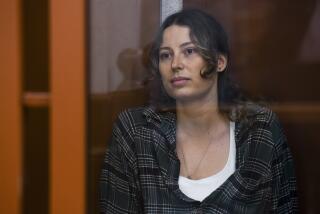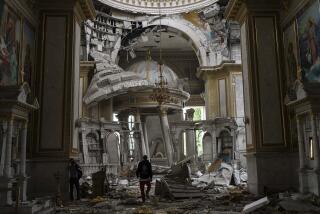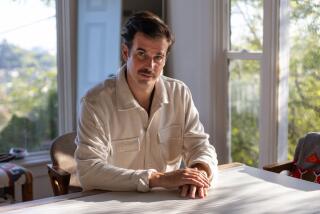Roaming Russia: St. Petersburg, with guide and without
St. Petersburg, Russia
The ancient cab we were in raced down the dark streets of St. Petersburg. My wife, Molly, and I had no idea where the driver was taking us. He was supposed to be returning us to our ship, but he didn’t seem to know where the dock was.
Straining to get a better look at the driver, I could see he had a mustache; the driver we had made arrangements with that morning had been clean-shaven. And Molly was sure this guy was very drunk.
“Stop the cab,” she yelled.
“I know good nightclub,” he said. “You want go?”
“We want you to stop,” I said.
He kept driving, faster and faster.
When we started planning our Baltic cruise aboard Holland America Line’s Westerdam last year, we had been warned about unscrupulous Russian cabdrivers who sometimes robbed passengers and left them stranded. But Molly and I were determined to see St. Petersburg on our own rather than with one of the many tours offered by the Westerdam, even though it meant we had to get visas and plan our own itineraries. (Travelers on ship tours don’t need visas.)
Our fellow travelers Mary Walton and Charles Layton took the easy way and chose a Westerdam tour. Mary and I thought that comparing our experiences would be helpful to other travelers. However honorable our motives, a certain competitiveness set in, and each of us hoped to have made the “right” decision.
Measured on price alone, it was a wash. Although our initial outlay was more, we could use our visa for the two days we would be ashore. Pro-rated, our total for the day was $327. Theirs was $313. But money was not the chief consideration: Molly and I like adventure.
Mary: Charles and I are not unadventurous people. We have river rafted in Ecuador and biked solo through Hungary. Later on this cruise, we explored Berlin on our own, ending up in a gay rathskeller where a long-haired blond German in shorts and pink boots led a sing-along to a jukebox filled with ‘70s tunes. But Charles and I did not relish going it alone in St. Petersburg, where few people speak English and even the alphabet is unreadable to us. The red tape in securing a visa frightened us. So we signed up for the Westerdam’s 8 1/2 -hour expedition, “Grand St. Petersburg.”
Don: Our adventure in Russia started at 9 a.m., when we walked down the gangplank. Because of its huge size, the Westerdam was tied up at a dock for cargo ships, three miles from the port’s exit gate. There were no cabs in sight. As we stood on the dock trying to figure out what to do, a large Russian approached us and asked in simple English whether we wanted a cab. He gestured toward a banged-up red car.
“How much to the Hermitage?” I asked. “Thirty dollars,” he said. Molly and I exchanged wary looks but accepted the ride.
We learned only his first name, Michael. But he drove well and got us to St. Petersburg’s famed museum without incident. We arranged to meet him at 10:30 p.m. at the same place where he had dropped us off.
Mary: Shortly after 8 a.m., as a four-piece brass band played “Stars and Stripes Forever,” we climbed aboard a big, comfy tour bus. It was a bright, cool Sunday morning, and we wheeled through the nearly empty streets of St. Petersburg, whose faded beauty is more sad than scenic.
Our guide was a repository of statistics. St. Petersburg has 316 bridges, 42 islands, 93 rivers and canals, 126 museums and 65 theaters. We stopped briefly -- 20 minutes max -- at St. Nicholas Cathedral, where we were told that Dostoevky’s Raskolnikov came to pray; at St. Isaac’s Cathedral, its gilded dome visible from miles away; and at the battle ship Aurora, which fired the first salvo of the 1917 Bolshevik Revolution.
Don: With 350 exhibition rooms and 3 million items, the guidebooks said it would take seven years to view everything in the Hermitage, even with spending only one minute in front of each piece. So Molly and I decided to visit exhibits that could be seen nowhere else.
For 3 1/2 hours, we walked through history, entering and exiting the palace’s elegant throne rooms, living rooms, and bedchambers. In the White Dining Room, we saw the mantle clock that is still stopped at 2:10, the early-morning hour in 1917 when the Bolsheviks entered the room and ousted the leaders of the fledgling Provisional Government, changing the course of Russian history.
During the 10 minutes we spent in the Gallery of 1812 with hundreds of portraits of Russian military officers who fought in the Napoleonic wars, four tour groups raced by. I looked in vain for Mary and Charles dutifully following an upheld umbrella or artificial flower. I wanted to cheer them on.
Mary: No doubt Don and Molly were hoping to spot us trailing our guide, a 28-year-old Putin facsimile named Ruslan Suprun. Though Suprun was the only real Russian we met in eight hours, he did speak excellent English and proved knowledgeable about the history of the Hermitage and the artists. He offered some not-in-the-guidebook asides. He pointed out black heel marks on the parquet floors, which were left, he said, by elegant Russian women who can’t resist high heels.
Just 7% of the museum’s mammoth collection is on display, but that includes 23 Rembrandts, 24 Van Dycks and 40 Reubens, and we saw them all. Afterward, Suprun turned us loose with 45 minutes left to sprint through the Monet, Rodin, Gaugin, Matisse and Picasso rooms. (I have since discovered that the Hermitage Website has a virtual tour in which you can view every room empty of bodies, with close-ups and histories of well-known works. This may be the way to go!)
Don: We left the museum at 2 p.m. and headed up Nevsky Prospekt, the main drag in town, lined with shops that seemed to offer little you couldn’t find in American cities. Even though it was Sunday, the sidewalks were crowded. We had lunch in a small restaurant well off the tourist track, where no one spoke English. As the waitress smiled to show she understood, we ordered lunch by pointing at pictures on the menu and were rewarded with juicy herring.
It was 3:30 p.m. by the time we headed toward the Anchikov Palace to buy tickets for a folklore concert that night. We had now been in St. Petersburg for more than five hours and had seen only one part of one floor of the Hermitage and thousands of people rushing up and down Nevsky Prospekt. But we were having a ball, luxuriating in our slow, careful pace.
Mary: What Don isn’t telling you is that they spent a lot of time with their noses in maps and their feet were starting to hurt. St. Petersburg, with wide streets, short but wide buildings and long distances between sights does not lend itself to strollers.
We were happy to traverse Nevsky Prospekt by bus. At one point we wheeled past the headquarters of the KGB, notable for being six stories high in a city with a four-story limitation. When it came to the KGB, who was counting?
Besides the Hermitage, we dropped by the richly decorated Church on Spilled Blood, but there wasn’t time to explore the fabled mosaics within; likewise the Byzantine-domed blue-and white Smolny Convent built for Elizabeth, daughter of Peter the Great. We did enter several gift shops, baited by the opportunity to use the restrooms. (One benefit of a guided tour is frequent bathroom breaks.)
Lunch was an efficient affair at the westernized Angleterre Hotel, with the other four busloads on the same tour. The main course was a pedestrian beef Stroganoff.
Don: The folklore show at Anchikov lasted until 9:45 p.m. This gave us just 45 minutes to walk almost two miles to our rendezvous with Michael, the cabdriver.
So Molly and I headed across town to the Nicholaevsky Palace, which had a similar folklore concert ending at 8:15 p.m. As we entered the palace, a string quartet was playing Vivaldi on the grand red-carpeted stairway leading to an ornate hall that was quickly filling with tourists. Our seats were close to the stage. Vigorous performances by dancers in colorful costumes and black boots, along with free champagne and caviar during intermission, revived our spirits after the long walk across town.
Mary: By 5 p.m., we were back on the Westerdam. As the 8 p.m. dinner hour approached and our friends hadn’t materialized, we imagined them, rightly as it turned out, having some exotic cultural experience. Had we cheated ourselves?
Don: On the way to a post-concert dinner, we came across a frail and elderly woman with a poorly bandaged foot and no shoes, who had collapsed on the sidewalk. She was agitated and weakly groaning a word that sounded like “telephone.” Molly helped her to a sitting position, and we flagged down two young men walking toward us, drinking beer. They seemed willing to help.
Halfway down the block, we looked back and could see the young men, their beers abandoned on a ledge, walking down the street with the woman propped up between them.
Perhaps because of the late hour, the restaurant was empty, even though a tour book described it as a winner. Having been disappointed with Russian dinners during a previous trip to Moscow, I ordered a steak with French fries, thinking that couldn’t be messed up. I was wrong. The meat was tough and the potatoes soggy. We were delighted, however, with an inefficient but eager-to-please teenage waitress, who clomped back and forth from the kitchen in high-heels she had yet to master.
We left the restaurant at 9:50 p.m., more than enough time for the 20-minute walk to our 10:30 p.m. rendezvous. We were almost there when a cabdriver hailed us.
When we realized we had the wrong guy heading the wrong way, and probably drunk to boot, we yelled for him to stop. He refused. When he slowed for a light, we swung the doors open, forcing him to halt completely, and jumped out. We were now more than 10 blocks from our rendezvous point and it was almost 10:30. We rushed down the street, stopping frequently to ask people whether we were headed toward the Hermitage.
Michael wasn’t there. We waited 20 minutes and then started looking for another cab.
Mary: At 11 p.m., when we found their stateroom empty, we became worried about Don and Molly. But what could we do?
Don: Standing on the Nevsky, we held up our hand and in less than a minute, a man in a private car stopped. Using sign language and speaking slowly, we indicated we wanted to go to the port where the big cruise ships docked. He agreed to take us there for 300 rubles, which was a third of what Michael had charged.
But he couldn’t find the dock. It took our rescuer more than an hour, and several inquires, to locate the entrance. He never once tried to renegotiate the price. Instead of paying the 300 rubles he had requested, we gave him 1,000, the price we had agreed to pay Michael.
We headed toward the entry gate, dreading the three-mile trek to the Westerdam. Clearing immigration in the small guardhouse, we stepped out into total darkness.
“Taxicab?” a voice said.
The five-minute ride cost $10 (286 rubles).
It was 11:45 p.m. when we reached the gangplank of the Westerdam. Five minutes later, we were sitting in the security of the ship’s Crows Nest bar, having a brandy.
I knew that Mary and Charles had probably learned a lot more than we did by taking the tour. But we had survived nicely without English and even participated in a small sidewalk drama. And we could talk about being kidnapped by a Russian cabdriver. Things like that never happen to you on a guided tour.
Mary: Alas, we have no harrowing stories to tell. And we missed all those portraits of Russian generals. As we reached other ports on the cruise, St. Petersburg started to fade from memory, the Hermitage but a blur of color. Yet we had enjoyed the day.
“Charles,” I asked, “did we make the wrong decision?”
“No,” he replied.
Comments? Email [email protected]
More to Read
Sign up for The Wild
We’ll help you find the best places to hike, bike and run, as well as the perfect silent spots for meditation and yoga.
You may occasionally receive promotional content from the Los Angeles Times.






